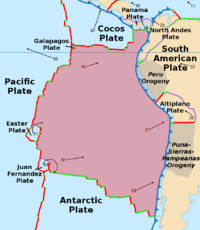
Photo from wikipedia
Abstract At mid-ocean-ridge spreading centers, the separation of lithospheric plates induces upwelling and pressure-release melting in the upper mantle. Many questions remain about the associated flow pattern, melt distribution, and… Click to show full abstract
Abstract At mid-ocean-ridge spreading centers, the separation of lithospheric plates induces upwelling and pressure-release melting in the upper mantle. Many questions remain about the associated flow pattern, melt distribution, and the interaction of spreading centers with hotspots. Based on the propagation of Rayleigh waves across arrays of ocean-bottom seismometers, we present shear wave attenuation and velocity models in the vicinity of the Juan de Fuca plate with the best resolution to date of any spreading center. There is strong attenuation centered at depths of 70–80 km, just below the expected dry solidus. The top of the attenuating region is somewhat deeper than predicted for the thermal effects of passive mantle upwelling beneath the spreading center. The shear velocity structure shows the lowest velocities west of the spreading center, particularly near Axial Seamount and high velocities east of the axis extending to a greater depth than predicted by the passive flow model. Together, these observations support a model in which buoyant upwelling and melt extraction west of the spreading center first depletes and dehydrates the mantle above the dry solidus and then the associated downwelling carries depleted, melt-free, residual mantle downward beneath the Juan de Fuca plate. The shear velocities and attenuation can be well matched with a model in which the dominant changes in the physical properties occur just before the onset of melting.
Journal Title: Earth and Planetary Science Letters
Year Published: 2018
Link to full text (if available)
Share on Social Media: Sign Up to like & get
recommendations!